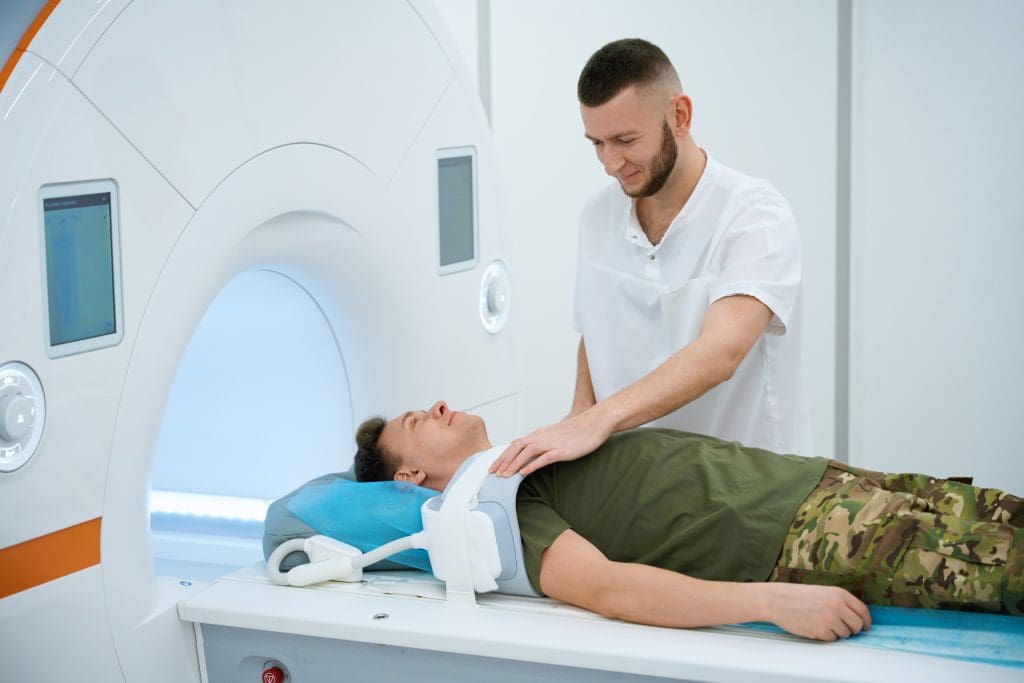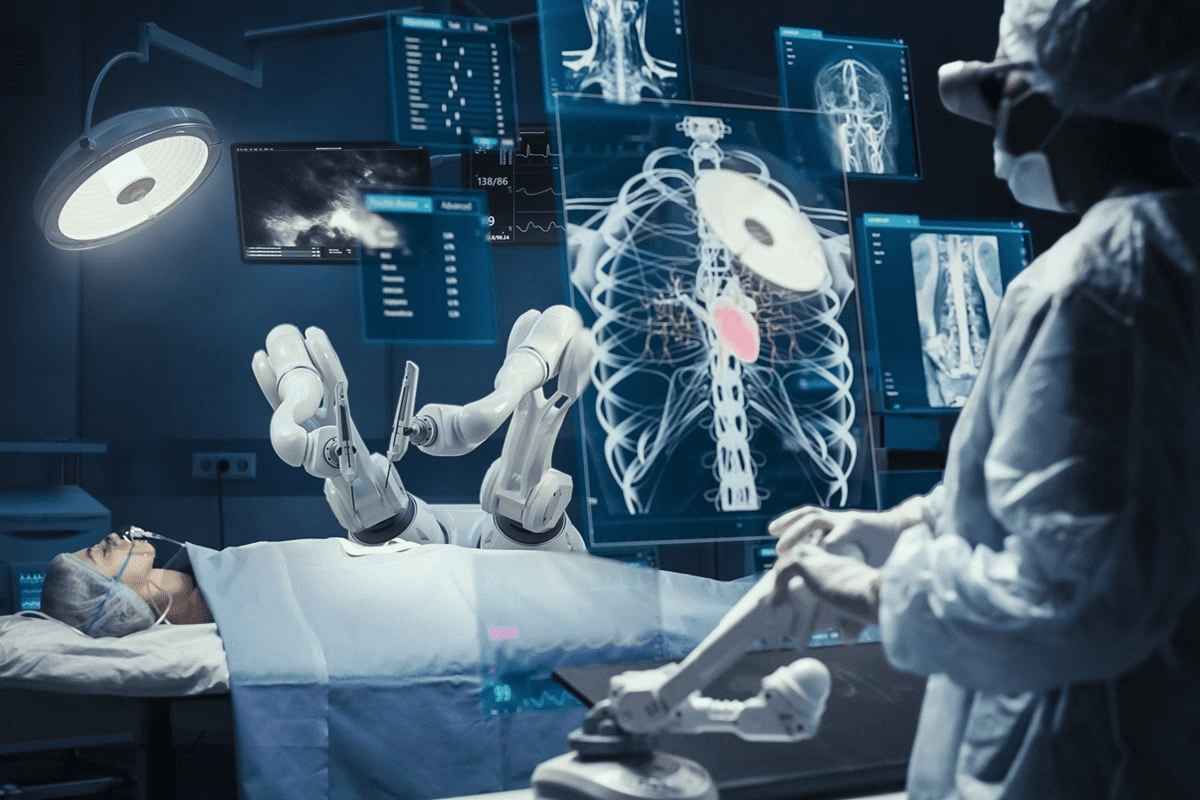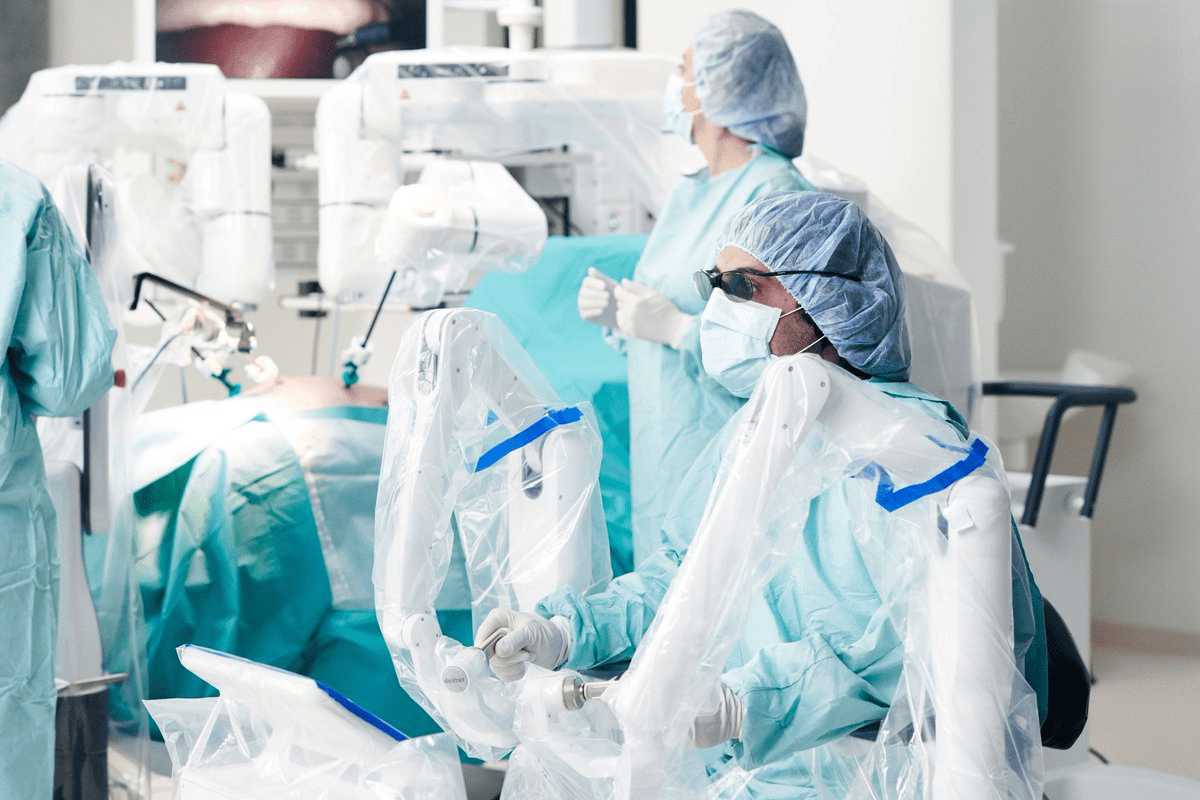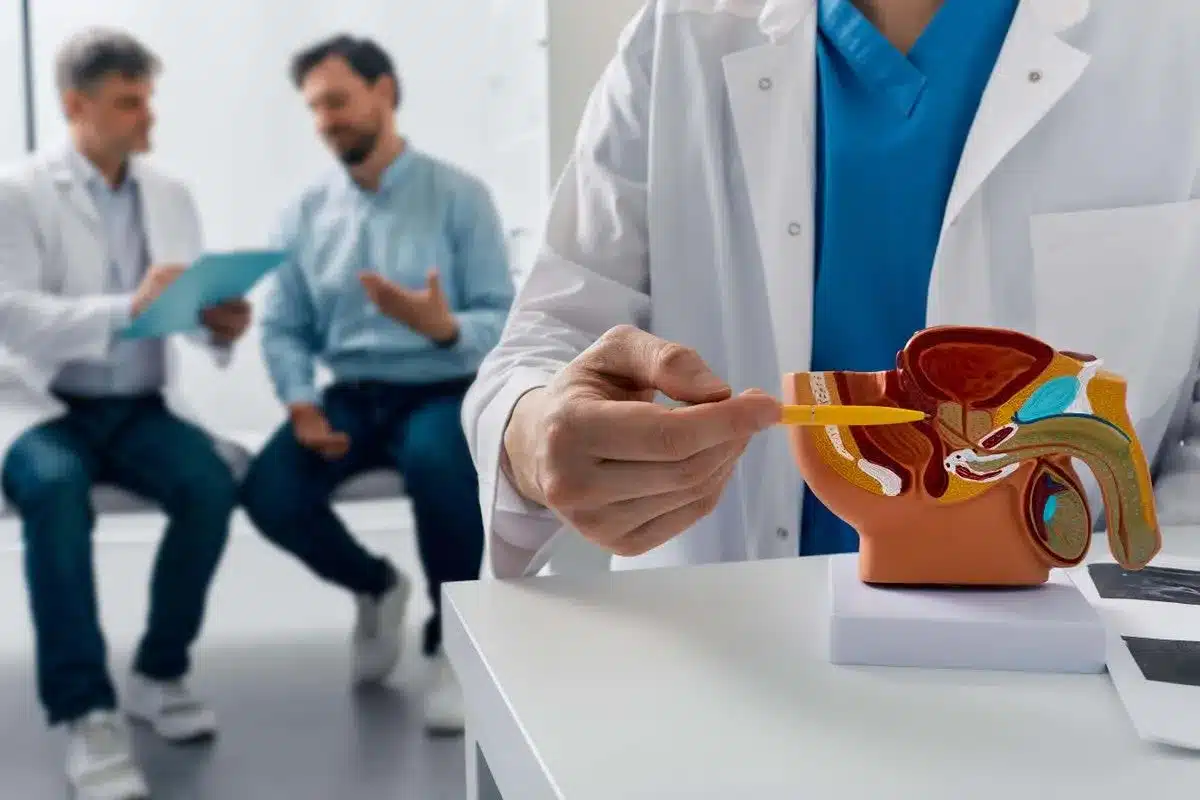Over 10 million nuclear medicine procedures are performed annually in the United States, many for cardiac care. The most common nuclear medicine procedure is the nuclear stress test, a vital tool for assessing heart function under stress.
Nuclear medicine uses tiny amounts of radioactive materials to help diagnose and treat diseases. The nuclear stress test is a vital tool for checking heart health. It helps us see how well the cardiac system is working. This way, we can spot problems early and plan the best treatments.
Key Takeaways
- Nuclear medicine procedures are used to diagnose and treat various diseases, including cardiac conditions.
- The nuclear stress test is a critical diagnostic tool for evaluating cardiac health.
- Small amounts of radioactive materials are used in nuclear medicine procedures.
- The nuclear stress test assesses the functioning of the cardiac system under stress.
- Effective treatment plans can be developed based on the results of the nuclear stress test.

Understanding Nuclear Medicine in Cardiology
Nuclear medicine is key in cardiology, giving us insights into the heart’s function and blood flow. It helps us diagnose and understand the severity of heart disease and other conditions.
Nuclear medicine uses small amounts of radioactive material to diagnose and treat diseases. In cardiology, it helps us see the heart’s structure and function. This lets us spot problems early.
Definition and Basic Principles of Nuclear Medicine
Nuclear medicine is a branch of medical imaging that uses radioactive tracers. It helps us see and assess the function of body parts, like the heart. These tracers build up in areas based on blood flow and activity.
Special cameras detect the radiation from these tracers. This lets us create detailed images of the heart’s anatomy and function. This info is key for diagnosing heart diseases and finding the best treatment.
Role in Cardiac Diagnostics
In cardiac diagnostics, nuclear medicine is vital. It gives us important info about the heart’s blood flow, function, and health. Techniques like myocardial perfusion imaging (MPI) help us see how well the heart muscle gets blood.
Myocardial perfusion imaging is great for spotting coronary artery disease and predicting future heart problems. Knowing the heart’s blood flow status helps us create personalized treatment plans. This improves outcomes and lowers the risk of complications.
Nuclear Stress Test: The Most Common Nuclear Medicine Procedure
The nuclear stress test is the most common test in nuclear medicine. It checks how well the heart works when stressed, usually through exercise or medicine.
What Makes It the Most Frequently Performed Test
This test is popular because it shows how well the heart’s blood flows and works. It helps find heart disease, see heart attack risks, and check if treatments work. It’s great for people with chest pain or trouble breathing.
It’s loved because it’s non-invasive. You don’t need surgery or instruments inserted. It’s safe and comfy for patients.
Different Types of Nuclear Stress Tests
There are many types of nuclear stress tests. The myocardial perfusion imaging (MPI) test uses a tiny bit of radioactive material to see the heart’s blood flow. We also use stress echocardiography, which mixes ultrasound with stress testing.
The pharmacological stress test is for those who can’t exercise. It uses medicine to mimic exercise’s effects on the heart.
- The exercise stress test, where patients walk on a treadmill or ride a stationary bike.
- The pharmacological stress test, used when exercise is not possible.
- The MPI test, which provides detailed images of the heart’s blood flow.
The Science Behind Nuclear Stress Testing
Nuclear stress testing uses radiopharmaceuticals to see how the heart works. It’s a key tool in cardiology. It helps doctors understand the heart’s function and blood flow.
Radiopharmaceuticals Used in Cardiac Imaging
Radiopharmaceuticals are special substances that light up the heart. They are detected by imaging devices to show detailed pictures. This lets doctors check blood flow and heart function.
The most used radiopharmaceuticals are Technetium-99m (Tc-99m) sestamibi, Tetrofosmin, and Thallium-201 (Tl-201). They target specific heart areas.
The right radiopharmaceutical depends on the patient’s needs and the test. For example, Tc-99m sestamibi is popular for its good image quality.
How Nuclear Tracers Work in the Heart
Nuclear tracers are taken up by the heart muscle based on blood flow. During a test, the tracer is injected at rest and then during stress. This could be exercise or medicine.
The imaging device captures the radiation from the tracer. It creates images showing blood flow to the heart muscle. This helps spot areas with less blood flow.
Doctors compare the images from rest and stress. This shows if there’s a problem with blood flow. It could mean coronary artery disease or other heart issues.
By looking at these images, doctors can see how the heart is working. They can find problems and plan the best treatment. This helps keep the heart healthy and prevent future problems.
Medical Indications for Nuclear Stress Tests
We use nuclear stress tests to check how well the heart works and find any problems. These tests are very important for diagnosing and treating heart diseases.
Symptoms That Warrant Testing
Certain symptoms may mean you need a nuclear stress test. These include:
- Chest pain or discomfort
- Shortness of breath
- Dizziness or lightheadedness
- Palpitations or irregular heartbeats
If you’re feeling any of these symptoms, your doctor might suggest a nuclear stress test. This test helps check your heart’s health.
Risk Factors and Preventive Screening
People with certain risk factors might need a nuclear stress test for preventive screening. These risk factors include:
- A family history of heart disease
- High blood pressure or hypertension
- High cholesterol levels
- Diabetes or pre-diabetic conditions
- Smoking or tobacco use
Early detection with nuclear stress testing can prevent serious heart problems.
Preventive screening is vital for keeping the heart healthy, mainly for those with many risk factors. Finding problems early allows us to act quickly and improve patient results.
What a Nuclear Stress Test Can Detect
Nuclear stress tests are key in checking the heart’s health. They look at blood flow and function. This tool shows how the heart works under stress, like during exercise or with medicine.
These tests show how the heart muscle reacts to stress. They help find problems. They also check the heart’s blood supply, spotting issues like coronary artery disease.
Identifying Coronary Artery Disease
Nuclear stress tests mainly look for coronary artery disease (CAD). CAD happens when the heart’s blood supply gets blocked by plaque. This can cause chest pain, heart attacks, and more.
The test shows the heart’s blood flow and spots areas that don’t get enough blood. By comparing rest and stress images, we find blockages in the heart’s arteries.
Assessing Heart Function and Blood Flow
Nuclear stress tests also check the heart’s function and blood flow. They look at how well the heart pumps, its size and thickness, and scar tissue from heart attacks.
These tests give a full picture of the heart’s health. This info helps us create a treatment plan that fits the patient’s needs.
| Condition | Description | Implications |
| Coronary Artery Disease (CAD) | Narrowing or blockage of coronary arteries due to plaque buildup | Reduced blood flow to the heart, potentially causing angina or heart attacks |
| Reduced Heart Function | Decreased efficiency in the heart’s pumping ability | Potential symptoms include fatigue, shortness of breath, and swelling |
| Abnormal Blood Flow | Uneven distribution of blood to the heart muscle | May indicate blockages or other cardiac issues requiring further investigation |
By using nuclear stress test results with other tests, we get a full picture of the heart. This helps us make a treatment plan that works best for the patient.
Preparing for a Nuclear Stress Test
A nuclear stress test needs careful preparation for the best results. We help our patients get ready for the test.
Pre-Test Instructions and Restrictions
Following specific pre-test instructions is key for accurate results. Patients are usually told to avoid certain medications and foods before the test. We give all the details during the first meeting.
Some common rules include:
- Avoid caffeinated drinks and products for at least 24 hours before the test
- Don’t smoke or use tobacco products on the test day
- Don’t eat a big meal before the test
Medications and Dietary Considerations
Some medications can change the test results. We might ask you to stop taking certain medications before the test.
What you eat is also important. We suggest:
| Dietary Item | Recommendation |
| Caffeine | Avoid for 24 hours |
| Heavy Meals | Avoid before the test |
| Certain Medications | May need to be stopped temporarily |
By following these tips, you can make sure your nuclear stress test is accurate. If you have any questions, our team is here to help.
The Nuclear Stress Test Procedure: Step by Step
The nuclear stress test checks how well the heart works when it’s stressed. It’s key for finding and managing heart disease. The test can be done by exercising on a treadmill or by taking medicine to stress the heart.
Exercise Stress Testing Protocol
For those who can exercise, the test starts with walking on a treadmill. The speed and incline go up to stress the heart. We watch the heart rate, blood pressure, and ECG during this time.
When the heart rate hits the target, a special dye is given to see how well the heart gets blood. After reaching the peak, the patient lies down for imaging. A gamma camera takes pictures of the heart at rest and under stress. These pictures help find any heart flow problems.
Pharmacological Stress Testing Protocol
For those who can’t exercise, a different test is used. This test uses medicine to make the heart work hard, like exercise. The medicine used depends on the patient’s health.
After the medicine works, a dye is given, and images are taken. These images are compared to ones taken when the heart is at rest. This helps see how well the heart is working.
| Aspect | Exercise Stress Test | Pharmacological Stress Test |
| Method | Physical exercise on a treadmill | Medication to simulate exercise effects |
| Patient Condition | Physically capable patients | Patients unable to exercise |
| Monitoring | Heart rate, blood pressure, ECG | Heart rate, blood pressure, ECG |
Both tests give a full view of heart health. Knowing how a nuclear stress test works helps patients get ready and understand the results.
Common Heart Procedures Following Abnormal Test Results
After an abnormal nuclear stress test, several heart procedures might be suggested. These tests show different heart issues, needing more checks.
From Diagnosis to Treatment Planning
When test results are not normal, we start a detailed check-up. This helps us understand the heart problem better. We do:
- More imaging tests to see how the heart works
- Coronary angiography to look at the heart’s arteries
- Check the patient’s health history and risk factors
These steps help make a treatment plan that fits the patient’s needs.
This way, patients get the right care for their specific issue.
Interventional Heart Procedures That May Be Recommended
Based on the diagnosis, several heart procedures might be suggested. These include:
- Angioplasty and Stent Placement: These are small, non-surgical ways to open blocked arteries and improve blood flow.
- Coronary Artery Bypass Grafting (CABG): A surgery to bypass blocked parts of the heart’s arteries.
- Heart Valve Repair or Replacement: These are surgeries to fix or replace heart valves.
These treatments aim to make the heart work better, lessen symptoms, and improve life quality.
We know heart procedures can seem scary. But with a great medical team and a plan made just for you, you can face these steps with confidence.
Interpreting Nuclear Stress Test Results
Understanding nuclear stress test results is key to knowing if you have heart disease. When you get a nuclear stress test, it shows how well your heart works under stress. This helps doctors find and treat heart problems.
Normal vs. Abnormal Findings
Nuclear stress test results can be normal or abnormal. Normal findings mean your heart gets enough blood flow at rest and under stress. This shows you likely don’t have serious heart disease.
Abnormal findings can mean different heart issues. They might show your heart doesn’t get enough blood flow during stress. This could mean you have heart disease.
What Different Patterns Mean
Each pattern in nuclear stress test results can point to different heart problems. For example, a reversible defect on a SPECT test means your heart gets less blood flow during stress but is okay at rest. This usually means you can treat the heart disease.
An irreversible defect means you’ve had a heart attack or permanent damage. Knowing this helps doctors plan the best treatment for you.
| Result Type | Description | Implication |
| Normal | Adequate blood flow to the heart muscle at rest and under stress | Low likelihood of significant coronary artery disease |
| Abnormal – Reversible Defect | Inadequate blood flow under stress, normal at rest | May indicate coronary artery disease amenable to treatment |
| Abnormal – Irreversible Defect | Scar tissue or permanent damage | Previous heart attack or permanent cardiac damage |
Understanding nuclear stress test results is complex. It requires knowing about heart function and what different findings mean. Doctors use these results to give patients the best care and treatment plans.
“The nuclear stress test is a valuable diagnostic tool that provides insights into the heart’s function under stress, enabling healthcare providers to identify and manage coronary artery disease and other cardiac conditions effectively.”
A Cardiologist
Risks and Safety Considerations of Nuclear Stress Tests
Nuclear stress tests are important for diagnosing heart issues. But, it’s key to know the risks and safety steps. We want to make sure our patients feel safe and informed.
Radiation Exposure Concerns
Nuclear stress tests use small amounts of radioactive tracers. This is safe for most people, but some worry about it. We use the least amount of radiation needed for clear images.
We talk to our patients about the radiation. This way, they know what to expect. The benefits of the test usually outweigh the risks.
The radiation in these tests is low, similar to a CT scan. We adjust the dose based on the patient’s age, weight, and the test’s purpose.
Other Possible Complications
There are rare complications from nuclear stress tests. Some might have an allergic reaction to the tracer. We watch patients closely to catch and treat any issues quickly.
Other issues include heart rate or blood pressure changes. These are usually short-term. But, in rare cases, it could lead to a heart attack. We’re careful and prepared for emergencies.
Knowing the risks helps us care for our patients better. Our team works hard to provide safe, quality tests. We’re here to answer any questions and make sure you feel safe.
Duration and Recovery: What to Expect
Knowing how long a nuclear stress test takes and how you’ll recover is key. We’ll help you understand what happens during and after the test.
How Long Does a Nuclear Stress Test Take?
A nuclear stress test usually lasts 3 to 4 hours. But the actual test time is much less. You’ll go through preparation, the test itself, and imaging. The whole process can be divided into several steps:
- Preparation: You’ll get ready by changing into a hospital gown and getting an IV line.
- Stress Test: The test itself, either through exercise or medicine, takes about 10-15 minutes.
- Imaging: After the test, you’ll wait for the radiopharmaceutical to be absorbed. Then, imaging takes about 15-30 minutes.
Post-Test Care and Radioactivity Clearance
After the test, you’ll be watched for a short time to make sure you’re okay. Post-test care includes:
- Drinking lots of fluids to get rid of the radiopharmaceutical.
- Avoiding close contact with pregnant women and kids for a short time because of the radioactive tracer.
- Knowing the radiopharmaceutical is usually gone from your body in 24-48 hours.
We know recovery and post-test care are important. By following your healthcare team’s instructions, you can have a smooth recovery. Remember, radioactivity clearance is a natural process. The substance is usually out of your body in a couple of days.
Knowing about duration and recovery after a nuclear stress test helps you prepare. If you have any worries or questions, talk to your healthcare provider.
Alternative Cardiac Diagnostic Tests
Nuclear stress tests are key in heart health checks. But, other tests are also important. They help when nuclear tests aren’t right or when more information is needed.
Non-Nuclear Stress Tests
For those avoiding radiation or not fit for nuclear tests, there are other choices. The exercise stress echocardiogram is one. It uses ultrasound and exercise to check the heart’s function.
The stress test with electrocardiogram (ECG) is another. It tracks the heart’s electrical activity during exercise. It’s not as detailed as nuclear tests but useful for some heart health checks.
Other Imaging Modalities
Cardiac MRI is a top choice for detailed heart images without radiation. It’s great for looking at heart structure and function.
Echocardiograms, or cardiac ultrasounds, use sound waves for heart images. They’re non-invasive and can be done at rest or during stress. They help check heart valves and overall function.
Coronary computed tomography angiography (CCTA) gives clear views of coronary arteries. It helps spot blockages and plan treatments. Each test has its own benefits, giving doctors many options for each patient.
Cost and Insurance Coverage for Nuclear Medicine Procedures
When thinking about a nuclear stress test, many wonder about the costs and insurance. Knowing these details is key to making smart health choices.
Average Costs in the United States
The price of a nuclear stress test changes based on several things. These include where you are, the facility, and the test’s needs. On average, it costs between $1,000 and $3,000. But, costs can change due to:
- Extra tests or procedures needed
- The type of radiopharmaceutical used
- Facility fees
- Doctor fees for reading the test
Here’s a simple look at what a nuclear stress test might cost:
| Service | Average Cost |
| Nuclear Stress Test | $1,000 – $3,000 |
| Radiopharmaceutical | $200 – $500 |
| Facility Fee | $500 – $1,000 |
| Professional Fee | $200 – $500 |
Insurance Considerations and Preauthorization
Insurance for nuclear stress tests varies by provider and policy. Most plans cover it if it’s needed. But, it’s important to check your coverage:
- See if your plan needs preauthorization
- Know your out-of-pocket costs, like deductibles and copays
- Check for any special rules or limits
Preauthorization means your doctor must get approval from your insurance before the test. It’s key to know if the test is covered and what you might pay out of pocket.
We suggest talking to your doctor and insurance about coverage. This way, you’ll understand the costs better.
Knowing about costs and insurance helps patients deal with the financial side of nuclear medicine tests. It makes it easier to get the tests you need.
Conclusion
We’ve looked at how important nuclear medicine is for heart health. The nuclear stress test is a key procedure in this field. It helps find heart disease, check how well the heart works, and plan treatments.
Nuclear stress tests are essential for heart health checks. They give us important information about the heart. By learning about these tests, patients can see how vital they are.
As we keep improving nuclear medicine, these tests will stay important for heart care. They help doctors make accurate diagnoses and choose the best treatments. This leads to better health outcomes and saves lives.
In short, nuclear medicine, like nuclear stress tests, is vital for today’s heart care. We use these advanced tools to give top-notch healthcare. They help patients get the best medical care possible.
FAQ
What is a nuclear stress test?
A nuclear stress test checks how well your heart works when it’s stressed. It uses a tiny bit of radioactive material to see how blood flows through your heart.
Why is a nuclear stress test performed?
Doctors use it to find and manage heart problems. This includes checking for blockages in the heart’s blood vessels.
How long does a nuclear stress test take?
It usually takes about 3-4 hours. This includes getting ready and recovering afterwards.
What are the risks associated with a nuclear stress test?
Risks include getting too much radiation and allergic reactions. There’s also a small chance of heart problems.
How is a nuclear stress test different from a regular stress test?
A nuclear stress test uses radioactive material to see blood flow. A regular stress test just checks heart activity and blood pressure.
Can a nuclear stress test detect blockages in the coronary arteries?
Yes, it can. It shows where blood flow to the heart is low, which might mean a blockage.
How do I prepare for a nuclear stress test?
Your doctor will give you specific instructions. This includes what to eat, any medicine changes, and avoiding certain substances.
What happens during a nuclear stress test?
You’ll get a small dose of radioactive material. Then, you’ll do stress testing, either by exercising or taking medicine. Your heart’s blood flow will be scanned.
How long do I remain radioactive after a nuclear stress test?
The radioactive material leaves your body in a few hours to days. It depends on the type used.
Are there alternative diagnostic tests to a nuclear stress test?
Yes, there are. Other tests like echocardiography, MRI, or coronary angiography might be used instead.





